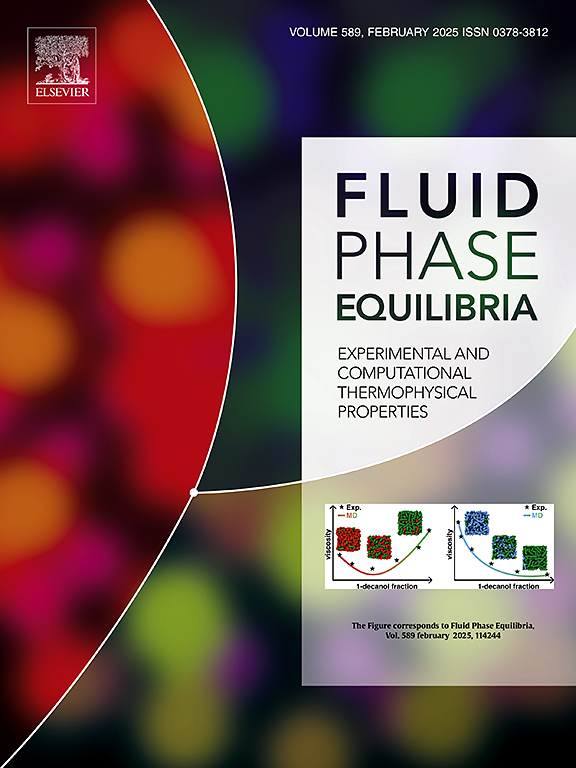Measurement and correlation of the solubility of Hydrogen in Acetophenone and 1-Methylnaphthalene
IF 2.8
3区 工程技术
Q3 CHEMISTRY, PHYSICAL
引用次数: 0
Abstract
Hydrogen (H2) solubility in liquid organic hydrogen carriers (LOHCs) is crucial for their widespread applications. This work investigates the solubility of H₂ x in two promising LOHCs: Acetophenone (APO) and 1-Methylnaphthalene (1-MN). Measurements were conducted using an isochoric saturation method within a temperature range of 293 to 363 K and pressures up to 5.8 MPa. The liquid densities ρ of APO and 1-MN, essential for characterizing H₂ solubility, were measured using a vibrating tube densitometer (DMA5000 M) at approximately 0.1 MPa. The experimental ρ for APO and 1-MN were compared with literature data and good agreement can be found. The Krichevsky-Kasarnovsky(K-K) equation was employed to correlate H₂ solubility x in APO and 1-MN, with deviations of mostly within 6 % and 10 %, respectively. Following, the behavior of H₂ solubility x concerning pressure along isothermal lines was analyzed. Finally, the thermodynamic parameter of dissolution of the two binary systems were studied. The enthalpy of dissolution is positive for all the systems, while the entropy of dissolution is negative. Under the same temperature, the Gibbs free energy of dissolution for the H₂ + APO system is smaller than that of the H₂ + 1-MN system.
氢在苯乙酮和1-甲基萘中的溶解度测定及其相关性
氢(H2)在液态有机氢载体(lohc)中的溶解度是其广泛应用的关键。本文研究了H₂x在两种有前途的lohc:苯乙酮(APO)和1-甲基萘(1-MN)中的溶解度。测量采用等时饱和度法,温度范围为293 ~ 363 K,压力为5.8 MPa。用振动管密度计(DMA5000 M)在约0.1 MPa下测量了表征H溶解度的APO和1-MN的液体密度ρ。将APO和1-MN的实验ρ值与文献数据进行了比较,结果吻合较好。Krichevsky-Kasarnovsky(K-K)方程用于关联H₂在APO和1-MN中的溶解度x,偏差分别在6%和10%以内。接着,分析了等温线上H₂溶解度x随压力的变化规律。最后,对两种二元体系的溶解热力学参数进行了研究。所有系统的溶解焓都是正的,而溶解熵是负的。在相同温度下,H₂+ APO体系的吉布斯溶解自由能小于H₂+ 1-MN体系。
本文章由计算机程序翻译,如有差异,请以英文原文为准。
求助全文
约1分钟内获得全文
求助全文
来源期刊

Fluid Phase Equilibria
工程技术-工程:化工
CiteScore
5.30
自引率
15.40%
发文量
223
审稿时长
53 days
期刊介绍:
Fluid Phase Equilibria publishes high-quality papers dealing with experimental, theoretical, and applied research related to equilibrium and transport properties of fluids, solids, and interfaces. Subjects of interest include physical/phase and chemical equilibria; equilibrium and nonequilibrium thermophysical properties; fundamental thermodynamic relations; and stability. The systems central to the journal include pure substances and mixtures of organic and inorganic materials, including polymers, biochemicals, and surfactants with sufficient characterization of composition and purity for the results to be reproduced. Alloys are of interest only when thermodynamic studies are included, purely material studies will not be considered. In all cases, authors are expected to provide physical or chemical interpretations of the results.
Experimental research can include measurements under all conditions of temperature, pressure, and composition, including critical and supercritical. Measurements are to be associated with systems and conditions of fundamental or applied interest, and may not be only a collection of routine data, such as physical property or solubility measurements at limited pressures and temperatures close to ambient, or surfactant studies focussed strictly on micellisation or micelle structure. Papers reporting common data must be accompanied by new physical insights and/or contemporary or new theory or techniques.
 求助内容:
求助内容: 应助结果提醒方式:
应助结果提醒方式:


